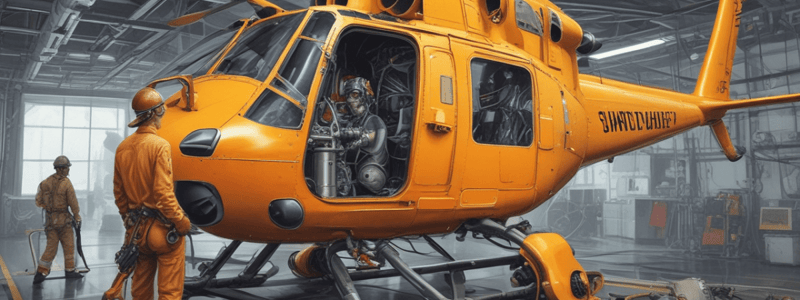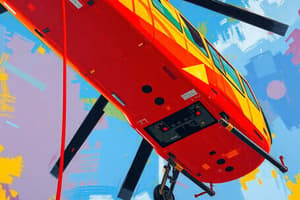Podcast
Questions and Answers
What is a common danger area around an engine?
What is a common danger area around an engine?
- Propeller on turbopropeller aircraft
- Jet exhaust effects
- Tarmac materials
- Pneumatic starter's plane of rotation (correct)
Why are ADF maintenance personnel generally not authorized to perform engine runs on rotary wing aircraft?
Why are ADF maintenance personnel generally not authorized to perform engine runs on rotary wing aircraft?
- Engine intake hazards
- Due to the risk of aircraft lift-off (correct)
- Jet exhaust effects
- Tarmac weight limits
What unique operating hazards do helicopters present?
What unique operating hazards do helicopters present?
- Weight limits on tarmac
- Weight limits in aircraft
- Danger from tarmac materials
- Jet exhaust effects (correct)
What is a significant danger during night-time operation of propeller-driven aircraft?
What is a significant danger during night-time operation of propeller-driven aircraft?
When can some ADF maintenance personnel perform engine runs on specific helicopter types?
When can some ADF maintenance personnel perform engine runs on specific helicopter types?
Which part of an engine around which dangers exist is mentioned in the text?
Which part of an engine around which dangers exist is mentioned in the text?
What is the main danger area associated with helicopter engines?
What is the main danger area associated with helicopter engines?
Which component of the helicopter spins at higher speeds than the main rotor assembly?
Which component of the helicopter spins at higher speeds than the main rotor assembly?
What can cause main rotor disc droop in a helicopter?
What can cause main rotor disc droop in a helicopter?
Why is it challenging to determine if a tail rotor is operating in certain lighting conditions?
Why is it challenging to determine if a tail rotor is operating in certain lighting conditions?
What danger is associated with engine intake in helicopters?
What danger is associated with engine intake in helicopters?
Which part of a helicopter can easily skid around the main rotor axis causing unexpected movement?
Which part of a helicopter can easily skid around the main rotor axis causing unexpected movement?
Why is it dangerous to perform maintenance or operate around helicopters?
Why is it dangerous to perform maintenance or operate around helicopters?
What precaution should be taken when performing maintenance near engine intake areas?
What precaution should be taken when performing maintenance near engine intake areas?
What can be a potential hazard to those near engine exhaust areas?
What can be a potential hazard to those near engine exhaust areas?
Why is it important to understand the danger areas shown in this figure?
Why is it important to understand the danger areas shown in this figure?
What effect does noise from gas turbine engines have on maintenance and flight line activities?
What effect does noise from gas turbine engines have on maintenance and flight line activities?
Why is hearing protection mandatory in circumstances involving gas turbine engines?
Why is hearing protection mandatory in circumstances involving gas turbine engines?
Flashcards are hidden until you start studying
Study Notes
Maintenance Hazards
- Caution must be exercised when performing maintenance around engine intake areas due to high temperatures and exhaust efflux.
- Exhaust gas velocity from turboshaft engines is negligible compared to turbojet exhaust nozzle velocity.
Danger Areas around Helicopters
- Intake and exhaust areas are hazardous, as shown in Figures 2 and 3.
- Noise levels from gas turbine engines can be dangerous to humans, requiring hearing and organ protection.
- Additional risks exist from turbine plane of rotation and pneumatic starter's plane of rotation.
- Turbopropeller aircraft have an additional risk from the propeller.
Rotary Wing Danger Areas
- Helicopters present unique operating hazards, regardless of who operates the aircraft.
- ADF maintenance personnel are generally not authorised to perform engine runs on rotary wing aircraft due to the risk of aircraft lift-off.
- Some exceptions exist on specific helicopter types where power-trains can be isolated from the engine.
Engine and Propulsion Hazards
- Helicopters have engine and propulsion danger areas, including:
- Main rotor disc
- Tail rotor (if single main rotor)
- Engine intake
- Engine exhaust
- Caution must be exercised when moving around helicopters, particularly during start-up and shut-down.
- Tail rotors spin at higher speeds than main rotor assemblies, making it difficult to determine if the rotor is operating in certain lighting conditions.
- Helicopters with skid landing gear can skid around the main rotor axis, causing the tail rotor plane of rotation to advance forward unexpectedly.
- Engine intake can ingest maintenance equipment and personnel.
Studying That Suits You
Use AI to generate personalized quizzes and flashcards to suit your learning preferences.




